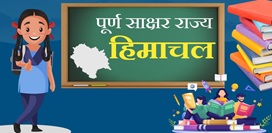21 September, 2025
5th Fully Literate State/Union Territory
Wed 10 Sep, 2025
Context:
- Himachal Pradesh has been declared the 5th fully literate State/Union Territory with a literacy rate of 99.3% (after Tripura, Mizoram, Goa, and Ladakh).
Key Points:
- Achievement announced on: International Literacy Day
- Occasion: Ullas Mela 2025, Shimla
- Announced by: Chief Minister of Himachal Pradesh (Sukhvinder Singh Sukhu)
- Ranked 1st in the country in terms of student-teacher ratio
Special List of Other Fully Literate States:
- Mizoram: India’s first fully literate state, literacy rate 98.2% (2025)
- Goa: Second state, literacy rate ~100% (2025)
- Tripura: Third, literacy rate ~95–96% (2025)
- Himachal Pradesh: Fourth, literacy rate 99.3% (September 2025)
- Ladakh (Union Territory): First fully literate UT, literacy rate >95% (2025)
Himachal’s Literacy Journey:
- After Independence: 7%
- 2011: As per Census, literacy rate reached 82.8%, higher than the national average of 74%
- 2023-24: According to National Sample Survey Office (NSSO) Periodic Labour Force Survey (PLFS), India’s overall literacy rate was 80.9%, while Himachal touched 99.3%
Key Success Factors
Policy Reforms and Government Initiatives:
- ULLAS Programme: This central initiative contributed significantly to literacy promotion. The programme involved more than 3 crore learners and 42 lakh volunteers, with material available in 26 Indian languages.
- Investment in Education: Himachal government invested heavily in infrastructure, teacher training, and educational resources in schools.
Definition of Literacy Rate
- Literacy rate defined under the Government of India’s ULLAS Programme.
- Under the ULLAS programme, more than 95% of the population above 15 years of age should be able to read, write, and perform basic arithmetic.
- Literacy rate is the percentage of the population that can read and write.
- Generally measured for people aged 15 years and above.
- Expressed in relation to a country, state, or geographical region at a particular point in time.
- Includes persons who can read with understanding and write in any language.
- Literacy rate indicates the percentage of population in a society or country that is educated or literate.
‘ULLAS: Nav Bharat Saaksharta Karyakram’
- A centrally sponsored scheme.
- Implemented by Government of India for the period 2022–2027.
- Aligned with National Education Policy (NEP) 2020.
- Objective: To make adults aged 15 years and above, who missed formal schooling, literate.
Main Objectives:
- Foundational Literacy & Numeracy
- Critical Life Skills (financial, digital, health, childcare, family welfare, etc.)
- Basic Education (primary, secondary, and equivalent education)
- Vocational Skills Development (for local employment)
- Continuing Education (courses in arts, science, technology, culture, sports, etc. for adults)
Implementation Highlights:
- Volunteer-based model: Implemented through volunteers who guide and train learners.
- Digital platforms: ‘ULLAS’ mobile app, DIKSHA portal and other tools provide online registration, study and assessment facilities.
- Certification: Literacy certificates jointly issued by NIOS and DSEL.
- Target: To make 5 crore adults literate during 2022–27 (1 crore per year).
- Financial Outlay: ₹1037.90 crore (Centre: ₹700 crore, States: ₹337.90 crore).
Features:
- Inclusivity: Covers illiterate adults (15+ years) across all States/UTs.
- Social Responsibility: Promotes sense of ‘Kartavya Bodh’ (duty consciousness) and community participation.
- Continuous Progress: Digital certificates for learners and teachers to enhance confidence and motivate continuous learning.
National Education Policy 2020 (NEP 2020)
Introduction:
- Announced on 29 July 2020 by Government of India.
- First major reform after the previous policy of 1986.
- Aim: To make India a global knowledge superpower and education system inclusive, holistic, flexible, and aligned to 21st-century needs.
Main Goals:
- Achieve 100% Gross Enrolment Ratio (GER) by 2030.
- Increase public expenditure on education to 6% of GDP.
- Provide quality, inclusive and equitable education for all.
- Focus on holistic development of students (physical, mental, social, moral).
- Promote technical, vocational, and skill-based education.
Key Features:
| Area | Features |
| School Education
|
– 5+3+3+4 structure (for age 3–18 years) – Emphasis on teaching in mother tongue/local language till Class 5 – Focus on Early Childhood Care and Education (ECCE) – Reduce dropout rate and ensure universal access to education |
|
Higher Education
|
– Multiple entry-exit system – UG courses 3 or 4 years, with certificate/diploma option – Single regulatory body under Higher Education Council of India (HECI) – Promotion of research and innovation |
|
Language Policy
|
– Three-language formula – At least two Indian languages compulsory – Priority to mother tongue |
|
Teacher Training
|
– Improved teacher training and evaluation system – Emphasis on teacher qualification and capacity building |
|
Other Initiatives
|
– Digital education, virtual labs, tech integration – Vocational education from school level – Provisions for inclusive and equitable education |
Structure (5+3+3+4):
- 5 years: Foundational Stage (3 years pre-primary + Classes 1–2)
- 3 years: Preparatory Stage (Classes 3–5)
- 3 years: Middle Stage (Classes 6–8)
- 4 years: Secondary Stage (Classes 9–12)
Literacy Rate in India as per Census 2011:
- Overall Literacy Rate: 74.04%
- Male Literacy Rate: 82.14%
- Female Literacy Rate: 65.46%
- State with Highest Literacy: Kerala, ~93.91% (Mizoram: 91.58%)
- UT with Highest Literacy: Lakshadweep, ~92.28%
- State with Lowest Literacy: Bihar, 63.82%
- Highest Male Literacy: Kerala, 96.11% (Lakshadweep, 95.56%)
- Highest Female Literacy: Kerala, 91.98% (Mizoram, 89.40%)
Himachal Pradesh:
- The name "Himachal" is derived from the Sanskrit words "himā" (snow) and "anchal" (lap), which aptly describes its geography nestled in the Himalayas
- Himachal Pradesh Day: 15 April
- Became a Category C state with the implementation of the Indian Constitution on 26 January 1950
- Became a Union Territory on 1 November 1956 and was expanded with the hilly areas of Punjab in the year 1966
- Gave full statehood on 25 January 1971 and became the 18th state of India under the Himachal Pradesh Act, 1970
- Capital: Shimla (Summer), Dharamshala (Winter)
Geographical Location:
- Jammu-Kashmir and Ladakh in the north
- Tibet (China) in the east
- Uttarakhand and Haryana in the south
- Punjab in the west
Administrative Division:
- Districts: 12
- Divisions: Kangra, Mandi, Shimla
- Assembly Seats: 68
- Lok Sabha Seats: 4
- Rajya Sabha Seats: 3
- Main Languages: Hindi (Official Language), Pahari Dialects, Punjabi, Kinnauri
Culture and Tourism:
- Folk Dance: Nati, Kinnauri, Lungi, Kayang
- Major Festivals: Kullu Dussehra, Minjar Fair, Shivratri Festival (Mandi), Lohri
- Religious Places: Jwalamukhi, Chamunda Devi, Hadimba Temple, Baijnath Temple
- Tourist Places: Shimla, Manali, Dharamshala, Dalhousie, Kinnaur, Spiti Valley
- UNESCO Heritage: Kalka-Shimla Railway
Symbol:
- State Animal: Snow Leopard
- State Bird: Western Tragopan
- State Tree: Deodar
- State Flower: Pink Rhododendron
- International Border: Shares a border of about 346 km with Tibet (China).
- Rivers: Ravi, Beas, Chenab, Yamuna and Sutlej are the major rivers here.
- Highest Peak: Reo Purgyil is the highest peak of Himachal Pradesh


















